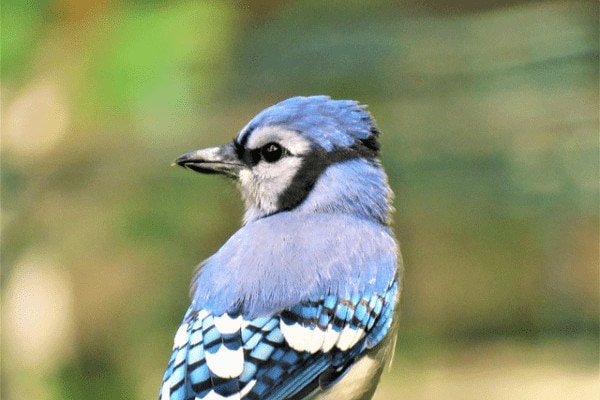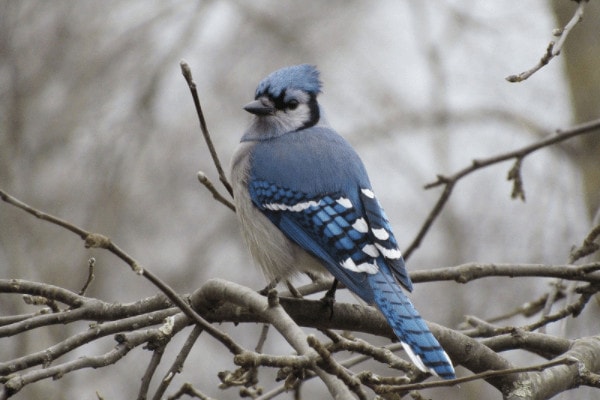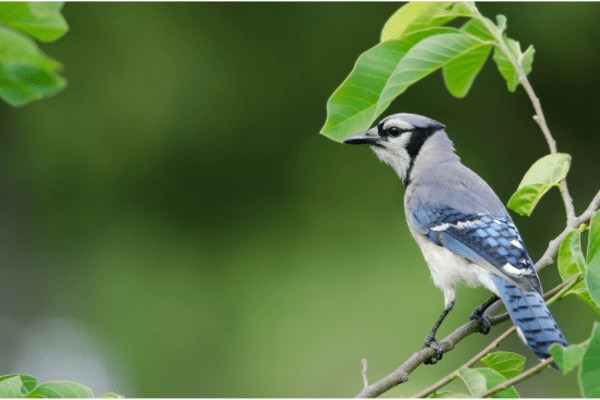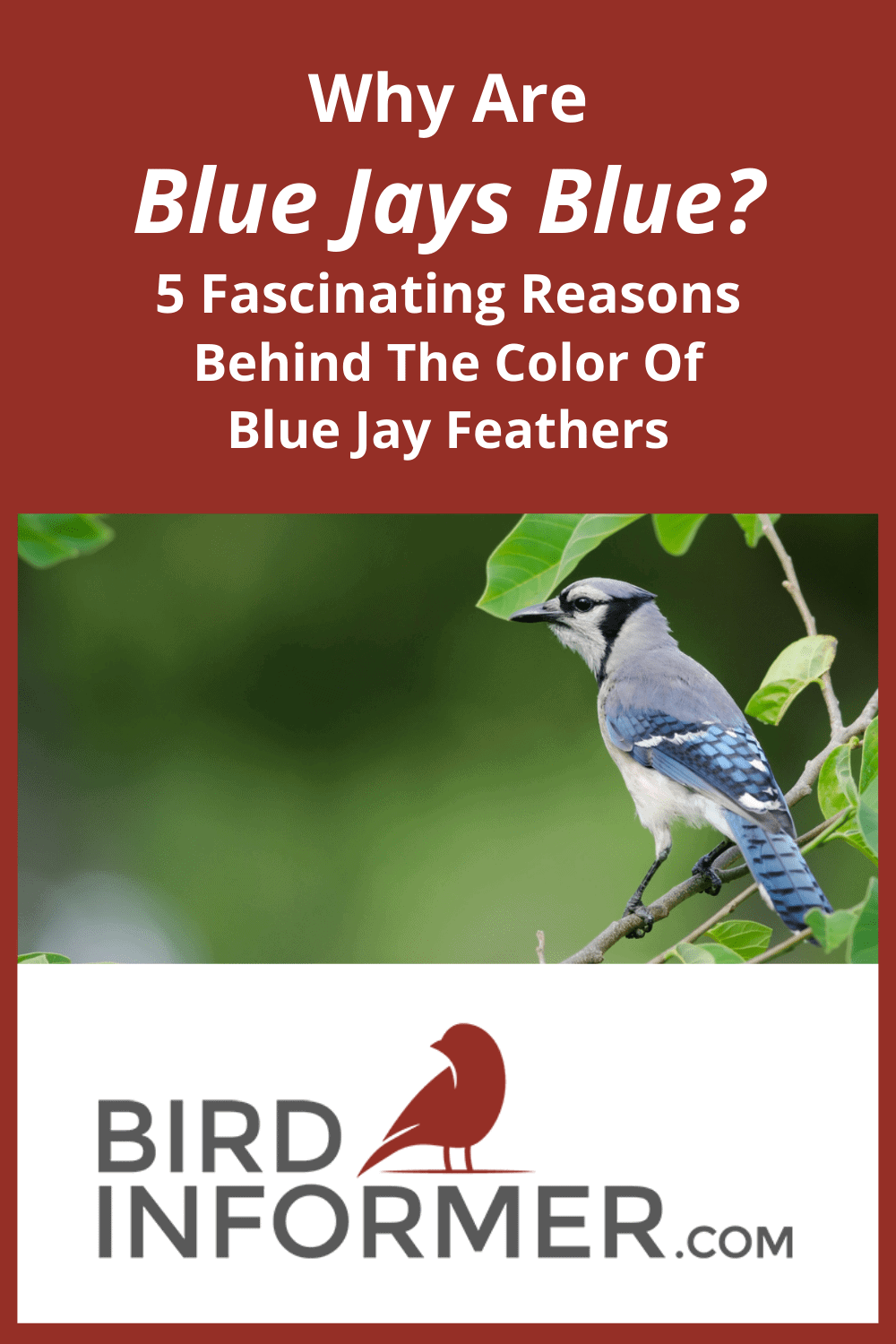Contents [show]
My nephew came up to me recently when he saw a blue jay at a bird feeder and asked if I knew why blue jays are the color blue. Up until that point, I hadn’t actually thought about it much. But the query began nagging at me and it wouldn’t let go, so I researched the question and came up with an answer that almost blew my mind, which I’ll share with you in a moment.
The Cornell Lab of Ornithology explains it by telling us that their feathers actually contain brown melanin, not blue. But they appear blue because scattered light reflects off of the surface of the feathers through modified skin cells. It turns out that in nature it’s very rare to find blue pigment.
And I have a lot more in store for you!
Believe it or not, I’d like to go even deeper on this topic and share a few important factoids that you may not have heard of. They include:
- The surprising true colors of blue jay feathers
- How light scattering plays a role in turning blue jay feathers blue
- The facts behind the optical illusion of all blue colored birds
- The actual colors of the majority of birds
- The backlighting technique that proves blue jay feathers aren’t really blue
Are you desperate to discover the specifics behind the mystery?
It won’t be long now, so keep reading to learn the truth.
True Colors: The Surprisingly Real Colors Of Blue Jay Feathers
This may seem hard to believe, but blue jay feathers aren’t actually blue. As a matter of fact, very brilliant scientific minds say that blue pigment doesn’t really exist in nature.
Most people will tell you that it’s simply brown, but it’s actually more of a grayish brown.
How are the colors of their feathers actually derived?
Well, it happens in two different ways.
First, the pigments found within the feathers of the Blue jay play a big part. As we now know, this coloring of the pigmentation is more like a gray and brown hue.
Second, the part of the process that makes these bird feathers appear blue has to do with light scattering, the reflection of the sun, and how the light reflects off of the feather microstructure to create a blue appearance.
It’s very scientific, to say the least.

Blue jays are an interesting bird. Some birders want to attract them to their yard, some don’t.
If you are birding enthusiast that wants to attract Blue jays to your yard, click the button below.
Light Scattering: The Essential Process Needed To Turn Blue Jay Feathers From Grayish Brown To Blue
Imagine for a second…
You pick up a grayish-brown feather on the floor in a relatively bright part of the park with ample light. You assume it’s either a pigeon feather, the feather from a house sparrow, or maybe it’s a tufted titmouse feather.
You show it to your friend and share your thoughts about the species. She corrects you and says that it’s actually a blue jay feather – and gives you the shock of a lifetime!
You think, “What do you mean this is a blue jay feather? Are you feeling all right or should I call the doctor?”
Your friend laughs off your silly comment and proceeds to explain the light scattering process.
With light scattering, it works very similarly to a prism. But as we all know, nature is very tricky in her own right, so the process is actually much more complex.
Believe it or not, within the wings of a blue jay you’ll find small pockets of air that also contain keratin, which is a protein.
These pockets are really tiny, to say the least. As a matter of fact, they are so ridiculously small that they’re considered minuscule nanostructures that you can only see under a microscope.
In fact, these microscopic nanostructures are so insignificant that they’re smaller than the visible light wavelength, which is the reason why they turn blue jay feathers blue.
As the light touches the small pockets, they absorb the entirety of the colors of the wavelength, with one major exception. They do not absorb the color blue.
The wavelength of blue colors is a refracted wavelength. And it’s this refraction that actually changes the color from grayish brown to blue.
Basically, it’s nothing more than an optical illusion. It’s a stunningly beautiful optical illusion, but an optical illusion nonetheless!
Have You Ever Wondered If Blue Jays And Northern Cardinals Are Related?
Click the button below to learn more…
The Optical Illusion: Other Blue Colored Birds Experiencing The Same Trick Of The Light
It’s hard to believe, but the blue-colored feathers of blue jays and all bluebirds are merely an astonishing optical illusion and nothing more.
How so?
As I mentioned above, it’s just a trick of the eye because of the way the light reflects off the feathers of blue jays and other blue-colored birds.
A list of other popular blue colored birds that experience this incredible optical illusion include:
- Indigo buntings
- Eastern bluebird
- Black throated blue warbler
- Mountain bluebirds
- Belted kingfishers
- Evening grosbeak
- Mexican jay
- Florida scrub jay
- Tree swallow
- Steller’s jay
- Cerulean warbler
- Island scrub jay
- And many more
Get all the facts about the differences between Eastern bluebirds and Blue jays.
Click the button below to learn more!

The Backlighting Technique: A Foolproof Way To Prove That Blue Jay Feathers Aren’t Truly Blue
Do you want to see this optical illusion in action?
It’s possible to change the colors of blue jay feathers using the backlighting technique.
Here’s how it works:
Step #1:
First, get your hands on a blue jay feather. If they regularly visit your backyard, pay attention and see if one of these feathers falls off of this beautiful bird.
Or…
You can buy them from one or more sellers on Etsy, eBay, or another online retail site.
But keep this in mind…
The Migratory Birds Treaty Act of 1918 actually makes it illegal to own the feathers of native birds. The United States entered into conservation treaties with the following countries:
- Canada in 1916
- Mexico in 1936
- Japan in 1972
- Russia in 1976
And two of these treaties were amended in recent years. The treaty with Mexico was amended in 1976 and the treaty with Canada was amended in 1995.
Ultimately, I’m sharing this information with you to potentially keep you out of trouble. Picking up a blue jay feather off the floor is harmless enough. But buying them online could potentially lead to trouble.
Step #2:
Second, take the feather and look at it under your normal everyday light. When you look at the feather, it certainly appears blue, just like it would when you look at a blue jay in its natural environment.
Step #3:
At this stage, I’d like you to backlight the feather. Ultimately, this means that I want you to provide illumination from behind the feather. Think of a backlit LCD screen or the backlight on your phone as a prime example.
What do you see?
With the backlighting in place, the prism effect is completely removed from the picture. Now the feather appears grayish-brown in color.
And light is no longer being reflected back, so the blue reflection has completely disappeared.
The Undeniable Truth: The Actual Colors Of The Majority Of Birds
I’d like to share one more interesting fact about birds before I wrap things up.
Did you know that all bird feathers are either the colors red, yellow, black, brown or orange?
Yes, it’s true. And the reason why?
This has to do with pigmentation. These pigments are imbued within the feathers of these birds.
Other birds with the colors purple and blue – like our friend the blue jay – do not get their colors from their feather pigmentation as we learned today.
Purple and blue appear because of the visible light spectrum being absorbed into the feathers and reflected to show these colors to our eyes.
The Bottom Line On Why Are Blue Jays Blue
Anyway…
I know what you’re thinking. You never imagined that there was this much science involved with creating the blue coloration in the feathers of blue jays and other gorgeous bluebirds.
But now you know the truth. And now you can share this information at a party and impress your friends, family, and neighbors!
Do you want the quick version in case you’re starting to forget your lessons already?
A brief recap includes:
- It surprised many of us to learn that blue jay feathers aren’t actually blue but more of a grayish brown tint
- We learned that when light touches tiny pockets of air on blue jays’ feathers, the full color spectrum is absorbed except for blue, which is reflected in the light
- It floored many of us to learn that blue feathers are really an optical illusion
- But we tested the optical illusion theory nonetheless using the backlighting technique to change the colors of blue jay feathers
- And we even found out that all bird feathers are technically yellow, brown, red, orange, or black due to pigmentation.
This is invaluable information to all birdwatching aficionados and experts that like to know and understand about such things. Now, the next time your nephew asks about the color of blue jay feathers, you can treat him to a detailed and fleshed-out answer like I did.


